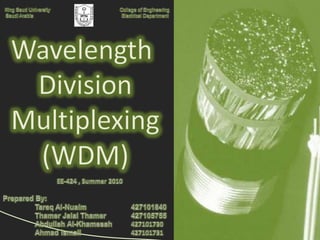
WDM & Optical Amplifiers
- 1. King Saud University College of Engineering Saudi Arabia Electrical Department WavelengthDivision Multiplexing (WDM) EE-424 , Summer 2010 Prepared By: Tareq Al-Nuaim 427101840 ThamerJalalThamer 427105755 Abdullah Al-Khamesah427101730 Ahmad Ismail 427101731
- 2. Outline: Multiplexing Optical Fiber WDM Conclusion contents Conclusion Conclusion Advantages Disadvantages Types contents contents Types technologies Types FDM TDM Exit Definition Comparison amplifiers
- 3. Optical Fiber Conclusion Advantages Disadvantages Types contents
- 10. Outline: Multiplexing Optical Fiber WDM Conclusion contents Conclusion Conclusion Advantages Disadvantages Types contents contents Types technologies Types FDM TDM Exit Definition Comparison amplifiers
- 11. Multiplexing Conclusion contents Types FDM TDM
- 18. Outline: Multiplexing Optical Fiber WDM Conclusion contents Conclusion Conclusion Advantages Disadvantages Types contents contents Types technologies Types FDM TDM Exit Definition Comparison amplifiers
- 19. WDM Conclusion contents Types technologies Definition Comparison amplifiers
- 23. WDM puts together multiple signals and sends them at the same time along a fiber, with transmissions taking place at different wavelengths. This turns a single fiber into the virtual equivalent of a handful of fibers. The most modern of these systems allows for much more than a handful of fibers.
- 24. WDM
- 28. WDM
- 30. DWDM is designed for long-haul transmission.
- 33. CWDM enables carriers to respond flexibly to customer needs in metropolitan regions, in other words the point and purpose of CWDM is short-range communications.
- 38. Optical Amplifiers Scattering and absorption in optical fibers cause attenuation of light signals, so for the receiver to interpret them properly signals need to be amplified, thus the use of optical amplifiers are essential.
- 40. Optical Amplifiers 3- Preamplifier A weak optical signal is amplified ahead of the photo detection process, where an optical preamplifier provides a large gain factor and a broad bandwidth so the receiver can detect the signal properly.
- 42. optical amplifier types Erbium-Doped Fiber Amplifier (EDFA): Erbium-doped fiber amplifiers is an example of doped fiber amplifiers (DFAs) and is by far the most important fiber amplifiers in the context of long-range optical fiber communications, It is the most common material for long-haul telecommunication applications due to its high power and large gain bandwidth.
- 44. The technologies for achieving the multiplexing in fiber optics are
- 45. The technologies for achieving the multiplexing in fiber optics 1- Thin-film filters (TFFs)
- 46. The technologies for achieving the multiplexing in fiber optics 2- Gratings
- 47. The technologies for achieving the multiplexing in fiber optics The choice of the technique depends on the application !
- 50. it can be used for short or long distance applications.
- 51. it transmits in very high data rates up to 100 Gb/s.
- 52. There are 6 Techniques of achieving the Multiplexing in Fiber Optics.
- 53. There are 3 types of Amplifiers used in the WDM.
- 55. Outline: Multiplexing WDM Optical Fiber Conclusion contents Conclusion Conclusion Advantages Disadvantages Types Optical Amplifier contents Types technologies Types FDM TDM Definition Comparison contents amplifiers
- 56. Optical Fiber Conclusion Advantages Disadvantages Types Optical Amplifier contents
- 58. Optical Amplifiers and their Types.
- 59. Erbium Doped Fiber Amplifiers.
- 63. Difficulty of implementing (repeater required for every mode). high cost of manufacturing. limited bit rates. Limitations of Repeaters
- 64. How to cancel the need for repeaters? Dispersion can be eliminated by the use of dispersion compensators. Attenuation can be compensated by using optical amplifiers.
- 66. 1- Optical Fiber Amplifiers Pumping using Laser diode. Active medium doped with rare earth minerals (Erbium, Praseodymium, Thulium, Neodymium…) Large gain (excitation life time 10ms).
- 67. 2- Semiconductor Optical Amplifiers Like optical fiber amplifiers but active medium is doped with semiconductor alloys (Phosphorus, Gallium, Indium and Arsenic). Smaller gain (excitation life time 0.1nS). Cheaper and easier to implement in optical systems.
- 68. 3-Fiber Raman Amplifiers 3- Fiber Raman Amplifiers Active medium is the fiber itself. Requires very long distance of active medium. Much smaller gain. Can be used at any wavelength.
- 69. 1.1-Erbium Doped Fiber Amplifier 1.1 Erbium Doped Fiber Amplifier The most commonly used optical amplifier in optical communication systems. This due to their high gain in the optical bandwidth (1530-1565 nm), which common used in communication system.
- 70. Gain is achieved by stimulating the Erbium ions using a laser diode pump at a wavelength of either 980 nm or 1480 nm. After population inversion is achieved, light at 1550 nm is amplified.
- 71. Like lasers, optical amplifiers depend on spontaneous emissions to amplify light signal. This is achieved by using pumping to achieve population inversion. After population inversion is achieved, passing light will cause stimulated emissions and light will be amplified.
- 72. Erbium Doped Fiber Amplifier
- 73. EDFA Performance Depends on The amount of doping in the fiber. The length and cross section of the Erbium doped fiber. The wavelength of the pumping laser. The power of the pumping laser. The power of the transmitted signal.
- 76. the best and most commonly used optical amplifiers are the Erbium doped fiber amplifiers.
- 78. Outline: Multiplexing WDM Optical Fiber Conclusion contents Conclusion Conclusion Advantages Disadvantages Types Optical Amplifier contents Types technologies Types FDM TDM Exit Definition Comparison contents amplifiers